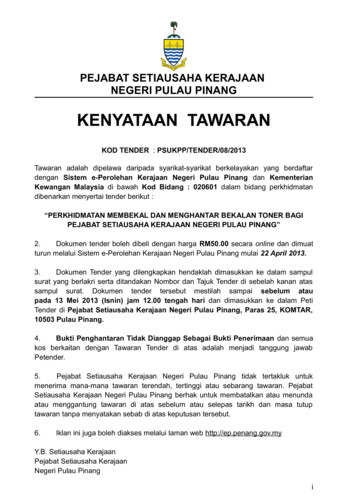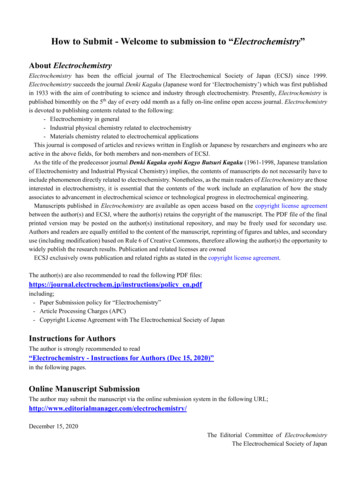Freddie Mac Could Further Reduce Reimbursement Errors
Federal Housing Finance AgencyOffice of Inspector GeneralFreddie Mac Could Further ReduceReimbursement Errors by ReviewingMore Servicer ClaimsEvaluation Report EVL-2014-011 August 27, 2014
Freddie Mac Could Further Reduce ReimbursementErrors by Reviewing More Servicer ClaimsWhy OIG Did This ReportAt AGlance———August 27, 2014Freddie Mac (along with Fannie Mae) supports the secondary residentialmortgage market by purchasing mortgages originated by banks and otherfinancial institutions. When Freddie Mac purchases a mortgage loan, itcontracts with mortgage servicers, such as large banks or mortgage companies,to handle routine loan activities, such as collecting and fowarding mortgagepayments.When borrowers become delinquent, a servicer may be required to maintainthe property, pay taxes and insurance, and liquidate the loan. After the loan isliquidated, the servicer seeks reimbursement of its expenses from Freddie Mac.Freddie Mac paid servicers 1.4 billion in 2013. In this report we discussthe process by which Freddie Mac reimburses its servicers for delinquencyexpenses, examine the controls it put in place to minimize erroneous payments,and estimate the rate of improper payments made by Freddie Mac in 2013.What OIG FoundFreddie Mac has a Multi-layered Process for Assessing the Validity of ServicerReimbursement ClaimsUnder its multi-layered review, Freddie Mac identified and deniedapproximately 126 million in erroneous claims in 2013. The followingsummarizes the process: Freddie Mac’s reimbursement system automatically denies any servicerclaims for reimbursement that do not meet established cost ceilings; Next, Freddie Mac personnel review certain higher-risk claims todetermine their reasonableness; and Finally, before any reimbursements are made, Freddie Mac selects arandom, statistically significant sample of claims for a detailed “prepayment review.” Servicers are required to submit supportingdocumentation for each expense set forth in the selected claims. If aservicer does not submit documentation by the required date, then theexpense in question will be denied, and the servicer may not resubmit aclaim for reimbursement of it.
Freddie Mac May be Able to Further Reduce Erroneous ServicerReimbursement ExpensesAt AGlance———August 27, 2014Freddie Mac’s process appears to be generally effective in reducing erroneousservicer reimbursement expenses. However, we estimate that in 2013 FreddieMac paid about 70 million to settle erroneous claims for reimbursement thatwere not subjected to the pre-payment review. Accordingly, we believe thatFreddie Mac may achieve additional savings by enlarging the sample of claimsthat is subjected to the prepayment review.We acknowledge that Freddie Mac would incur additional expenses, suchas personnel costs, if it expanded the size of the prepayment review samplebeyond the current percentage of claims reviewed. However, we estimate thatdoubling the percentage of claims reviewed would result in additional savingsof nearly 7 million at a cost of only about 1 million in higher Enterprisepersonnel expenses.At some point, however, the costs associated with expanding the pre-paymentreview sample would likely exceed the potential financial benefits.What OIG RecommendsWe recommend that FHFA require Freddie Mac to:1. Determine, by means of a cost-benefit analysis, whether to increase thesize of the sample of reimbursement claims that it subjects to the prepayment review.2. If warranted by the result of the cost-benefit analysis, increase the sizeof the sample of reimbursement claims that it subjects to pre-paymentreview.FHFA agreed that by August 31, 2014, it would direct Freddie Mac tocomplete a cost-benefit analysis and, if warranted, to increase the sample sizeby October 31, 2014.
TABLE OF CONTENTS .AT A GLANCE .2ABBREVIATIONS .6PREFACE .7CONTEXT.8The Servicers’ Role in Protecting Freddie Mac’s Financial Interests .8Freddie Mac’s Servicer Reimbursement Operations .9Freddie Mac Employs a Three Tier Process to Determine Whether to Pay aClaim .10Business Rules .10Queues .11The Pre-Payment Review Process – an Additional Level of Scrutiny .11Freddie Mac Enhanced its Reimbursement System in Response to Internal AuditReports.13FHFA’s Oversight of Freddie Mac’s Reimbursement System.14FINDING .15Freddie Mac May Be Able to Reduce Servicer Reimbursement Errors by FurtherExpanding its Prepayment Review Sample.15Freddie Mac’s Estimated Net Overpayments Were Nearly 70 Million in 2013 .15Expanding the Prepayment Review Sample Could Increase ReimbursementSavings .16CONCLUSION.18RECOMMENDATIONS.19OBJECTIVE, SCOPE, AND METHODOLOGY .20Objectives .20Scope.20Methodology.20OIG EVL-2014-011 August 27, 20144
Methodology for Estimating Potential Overpayments in Population of ClaimsNot Reviewed by Freddie Mac.21APPENDIX A.23FHFA’s Comments on FHFA-OIG’s Findings and Recommendation .23APPENDIX B: .25Summary of Questioned Costs .25ADDITIONAL INFORMATION AND COPIES .26OIG EVL-2014-011 August 27, 20145
ABBREVIATIONS .Desk ReferenceFreddie Mac Expense Reimbursement Desk ReferenceEnterprisesFannie Mae and Freddie MacFannie MaeFederal National Mortgage AssociationFHFA or AgencyFederal Housing Finance AgencyFreddie MacFederal Home Loan Mortgage CorporationHERAHousing and Economic Recovery Act of 2008IPERAImproper Payments Elimination and Recovery Act of 2010OIGFederal Housing Finance Agency Office of Inspector GeneralOMBOffice of Management and BudgetREOReal Estate OwnedGuideFreddie Mac Single Family Seller/Servicer GuideOIG EVL-2014-011 August 27, 20146
PREFACE.Since the 2008 financial crisis, Fannie Mae and Freddie Mac (together, the Enterprises) havepaid their servicers billions of dollars to manage the properties that secure their mortgages.The servicers carry out their management duties in accordance with the Enterprises’ servicerguidelines and other applicable documents and agreements. From time to time servicers arerequired to advance payments on behalf of borrowers who have become delinquent. For themost part, such payments are made to cover property maintenance, insurance, taxes, and loanliquidation costs. Thereafter, the Enterprises reimburse the servicers.In September 2013, we issued a report on Fannie Mae’s servicer reimbursement operations.1In it, we made three findings. First, errors made by the contractor that Fannie Mae hired toprocess its servicers’ reimbursement claims caused Fannie Mae to overpay its servicers about 89 million in 2012. Second, the method by which Fannie Mae oversaw its contractor wasnot effective in minimizing such overpayments. And third, FHFA’s oversight of FannieMae’s operations was minimal prior to 2013.In this report we focus upon Freddie Mac’s reimbursement operations, i.e., how Freddie Macreimburses its servicers for delinquency expenses. We also estimate the rate of improperpayments made by Freddie Mac in 2013.2This evaluation was led by Bruce G. McWilliams, Senior Investigative Evaluator, andOmolola Anderson, Senior Statistician, with assistance from Desiree I-Ping Yang, FinancialAnalyst, and overseen by Angela Choy, Director. We appreciate the cooperation of all thosewho contributed to this effort, especially members of the Default Fees and Claims Departmentat Freddie Mac.The report has been distributed to Congress, the Office of Management and Budget, andothers, and will be posted on OIG’s website, www.fhfaoig.gov.Richard ParkerDeputy Inspector General for Evaluations1See Evaluation of Fannie Mae’s Servicer Reimbursement Operations for Delinquency Expenses (EVL-2013012) (September 18, 2013), pdf.2We define the term “improper payments” to refer to the combination of payments in excess of what isrequired, i.e., an “overpayment,” and less than what is required, i.e., an “underpayment.”OIG EVL-2014-011 August 27, 20147
CONTEXT .The Servicers’ Role in Protecting Freddie Mac’s Financial InterestsFreddie Mac (along with Fannie Mae) supports the secondary residential mortgage market bypurchasing mortgages originated by banks and other financial institutions. The Enterpriseseither hold the mortgages in their investment portfolios or pool them into mortgage-backedsecurities (MBS), the performance of which the issuing Enterprise guarantees. In either case,when Freddie Mac purchases a mortgage, it has a financial interest in maintaining the value ofthe home that secures its mortgage.Freddie Mac goes about maintaining the value of the mortgages that it owns or guarantees bycontracting with servicers to perform a variety of duties, including: Collecting mortgage payments and processing late payments; Forwarding payments from the homeowners to Freddie Mac; Maintaining escrow accounts to pay property taxes and insurance; and Handling default proceedings and foreclosures as necessary.As long as a borrower is current on his or her loan, then the servicer merely collects mortgagepayments and forwards them to Freddie Mac.3 The servicer’s responsibility increases whenthe borrower defaults on the loan. Then the servicer must assist the borrower in finding asolution to the delinquency problem in a manner that protects Freddie Mac’s financialinterest. For example, the servicer may help the borrower obtain an appropriate foreclosurealternative, such as a loan modification or a short sale.4If, however, a borrower cannot repay the mortgage or obtain a foreclosure alternative, then theservicer is required to liquidate the mortgage through foreclosure. After the loan is liquidated3The servicer may also collect escrow funds for taxes, insurance, or homeowner association (HOA) dues andmake payments in furtherance of such expenses.The servicer retains a small percentage of the payment as a servicing fee. See FHFA’s Supervision of FreddieMac’s Controls over Mortgage Servicing Contractors (AUD-2012-001) (March 07, 012-001 0.pdf.4Foreclosure alternatives include payment plans, forbearance agreements, loan modifications, short sales, ordeeds-in-lieu of foreclosure. When a mortgage loan is modified its terms are adjusted to create a moreaffordable monthly payment for the borrower. Upon completion of the modification, the mortgage is broughtcurrent. In a short sale the borrower is permitted to sell the property for an amount that is less than the balanceof the mortgage, and, thus, avoid foreclosure.OIG EVL-2014-011 August 27, 20148
the servicer seeks reimbursement from Freddie Mac for the various expenses it incurredduring the foreclosure process. The mortgage servicing process is illustrated in Figure 1,below.FIGURE 1. ENTERPRISE MORTGAGE SERVICING PROCESSFreddie Mac’s Servicer Reimbursement OperationsFreddie Mac's Claims Department manages its servicer reimbursement operations. Once aloan has been liquidated, the servicer5 submits an electronic claim to the Claims Departmentthrough Freddie Mac's Reimbursement System.6 A claim consists of various line itemsthat correlate to the expenses the servicer incurred in attending to Freddie Mac's mortgageloan. Typical expense line items include attorney fees and legal costs incurred during theforeclosure process, property taxes, insurance, and property maintenance. In 2013, FreddieMac paid 1.4 billion to 460 servicers for such expenses. Although Freddie Mac has manyservicers, its top 10 servicers - relative to total reimbursements - accounted for 87 percent ofall reimbursement payments made by Freddie Mac in 2013. See Figure 2.5In some instances, parties other than servicers submit reimbursement claims to Freddie Mac through theReimbursement System. Throughout this report the term "servicer" is used to mean all those entities thatengage in default management services and submit claims through Freddie Mac's Reimbursement System.6The Claims Department uses VendorScape software developed by CoreLogic, Inc., a real estate dataprovider. CoreLogic manages Freddie Mac's software and houses its database.OIG EVL-2014-011 August 27, 20149
FIGURE 2. SERVICER COMPOSITION OF FREDDIE MAC’S REIMBURSEMENTS IN 2013Rank12345678910ServicerJP Morgan Chase BankWells Fargo Home Mortgage IncBank of AmericaNationstar Mortgage, LLCCitimortgage IncTop Five ServicersOcwen Loan Servicing, LLCUS BankPNC BANK, NACenlar FSBFifth Third BankTop Ten ServicersOther 450 ServicersTotalPercent : Freddie Mac. Numbers may not add due to rounding.Freddie Mac Employs a Three Tier Process to Determine Whether to Pay a ClaimFreddie Mac’s Reimbursement System is comprised of three parts: business rules, queues, andpre-payment review. These parts are defined and described below.Business RulesGenerally, Freddie Mac reimburses a servicer after ensuring that its claim falls within theparameters specified in its Single Family Seller/Servicer Guide (Guide).7 These parameters,known as business rules, set forth how much and how frequently Freddie Mac will pay forcertain items.8Freddie Mac employs the business rules to approve, adjust, or deny claims based uponestablished expense limits and the date upon which the expense was incurred. If a servicerexpects to incur an expense that will exceed the limits set by Freddie Mac, then it must submita request for pre-approval (RPA) prior to submitting the claim. If Freddie Mac approves the7Freddie Mac does not require a servicer to submit supporting documentation at the time the servicer submitsits expense reimbursement claim. However, Freddie Mac may require a servicer to submit supportingdocuments at another point in the reimbursement process. For example, documentation is required if a claimis subjected to pre-payment review, which is discussed later in this report.8The business rules are programmed into the reimbursement system’s software.OIG EVL-2014-011 August 27, 201410
exception in the RPA, then it will be programmed into the reimbursement system as anacceptable expense. Otherwise, the request for reimbursement will be automatically reducedor denied if it exceeds the limits or is not reimbursable.QueuesThe Reimbursement System targets higher risk claims for additional review by the ClaimsDepartment. These claims are identified by the business rules and are routed to workflowqueues for further analysis. Although the claims are reviewed for reasonableness, theclaimants are generally not asked to provide documentary evidence of the expensesunderlying the claims.The Pre-Payment Review Process – an Additional Level of ScrutinyAfter all adjustments from the business rules and queues have been applied, but beforereimbursement is paid, a random, statistically significant sample of the claims is selected for apre-payment review.9 The servicers that submitted the affected claims are required to submitdocumentation supporting each line item within seven business days.10 If a servicer fails tosubmit documentation by the required date, then the line item in question will be denied, andthe servicer may not resubmit a claim in connection with it.According to Freddie Mac, supporting documentation includes, among other things, copiesof original bills or invoices for expenses such as legal fees and costs, property inspections,property preservation costs, primary mortgage insurance premiums, and condominium/HOA/Planned Unit Development.11After receiving an automated confirmation that documentation has been received on a claim,the pre-payment reviewer assigned to the claim must manually confirm that documentationexists for each line item within the claim. After reviewing the documents, the reviewerapproves, denies, or adjusts the amount in each line item.9The Claims Department refers to the review as a “pre-audit review.” Since this review occurs prior topayment, for presentational purposes we refer to the process as the “pre-payment review.”10A servicer that requests an extension may be provided with up to five additional business days to submitrequired documentation.11Less frequently submitted standard documentation includes: copies of loan histories for the twelvemonths prior to the due date of the last paid installment up to the date upon which the history was requested,and information concerning tax payments. In some cases in which taxes are paid as a lump sum, the claimantmust provide a breakdown from the taxing authority that specifies the tax amount, including late charges,penalties, and interest paid, if any.The Claims Department noted that some smaller servicers with lower claim volumes may not consistentlyadhere to the documentation submission requirements and has proposed additional training as a remedy.OIG EVL-2014-011 August 27, 201411
Although the pre-payment review results in additional adjustments in reimbursementpayments, the majority of payment adjustments are made as a result of Freddie Mac'sapplication of its business rules. See Figure 3.FIGURE 3. DISTRIBUTION OF CLAIM REIMBUR
Reimbursement Claims Under its multi-layered review, Freddie Mac identified and denied approximately 126 million in erroneous claims in 2013. The following summarizes the process: Freddie Mac’s reimbursement system automatically denies any servicer claims for
using the Freddie Mac CAC option in Pipeline Services.GSE You can assign loans selected from your Pipeline, or all your loans, using the Freddie Mac CAC options in the Pipeline menu. Loans can be assigned individually or in batches of up to 500. To Assign Selected Loans to an Aggregator Using Freddie Mac CAC: 1. Close all your loans. 2.
Chapter 1 MAC Address Configuration Commands 1.1 MAC Address Configuration Commands 1.1.1 mac address-table static Syntax [no] mac address-table static mac-addr vlan vlan-id interface interface-id To add a static MAC address, run mac address-table static mac-addr vlan vlan-id interface interface-id. To cancel the static MAC address, run no mac
Fannie Mae Loans Are More Sensitive to the Home Price Change Compare to Freddie Mac Loans and When UpdatedCLTV Is Between 100% - 180% 0.0% 0.2% 0.4% 0.6% 0.8% 1.0% 1.2% 1.4% 1.6% 10 30 50 70 90 110 130 150 170 Fannie Mae Freddie Mac Sources: Fannie Mae, Freddie Mac, Moody’s Analytics (%) UpdatedCLTV
objectives in Freddie Mac's Equitable . Housing Finance Plan may be subject . to change based on factors including FHFA review for compliance with Freddie Mac's statutory charter, specific FHFA approval requirements and safety and soundness standards, FHFA guidance and directives, regulatory requirements, Senior Preferred Stock Purchase
Freddie Mac is a US government-sponsored enterprise whose mission is to provide liquidity, stability, and affordability to the US housing market. It does this principally by purchasing mortgages and securitizing them into bonds that are sold to investors. Freddie Mac Single-Family's green bond framework outlines eligible
Freddie Mac Duty to Serve Underserved Markets Plan Manufactured Housing - MH2 . Freddie Mac's strategy is intended to respond to the public input we received regarding manufactured housing market needs, while enabling us to make informed decisions about an appropriate level of loan purchases within the bounds of safety and soundness.
Since Congress chartered us in 1970, Freddie Mac's mission has been to provide liquidity, stability and affordability to all corners of the U.S. housing market. Supporting affordable housing and access to credit is an integral part of what we do. In 2008, Congress called on Freddie Mac to provide leadership by developing loan products and .
Introduction to Logic Catalog Description: Introduction to evaluation of arguments. Concentration on basic principles of formal logic and application to evaluation of arguments. Explores notions of implication and proof and use of modern techniques of analysis including logical symbolism. Credit Hour(s): 3 Lecture Hour(s): 3 Lab Hour(s): 0 Other Hour(s): 0 Requisites Prerequisite and .























